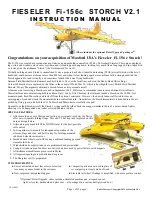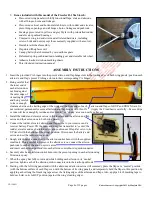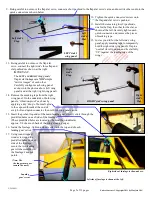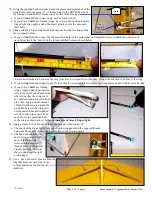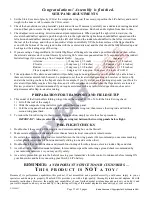
Page 12 of 13 pages
Congratulations! Assembly is finished.
SETUP AND ADJUSTMENTS
1.
Set the Storch‟s center of gravity (CG) at the composite wing rod. If necessary, reposition the LiPo battery and/or add
weight to the nose or tail to ensure the CG is correct.
2.
Check the heat-shrink covering material‟s joints and surfaces. If necessary, carefully use a dedicated covering-material
iron and heat gun to secure the edges and to tighten any loosened areas. Re-check and re-tighten from time to time.
3.
Check/adjust servo centering, direction and end-point adjustments. When you pull the right stick toward you, the
elevator should deflect upwards; push the right stick to the right and the right aileron should deflect upwards and the
left aileron should deflect downwards; push the left stick left and the rudder should deflect to the left as viewed from
the rear of the fuselage, and with your transmitter‟s flaps control fully UP, the bottom surface of the flaps should be
even with the bottom of the wing (and in line with the centered ailerons) and the slats should be fully retracted up and
back against the leading edge of the wing.
4.
If you are using a Computer Radio: For initial flights set all linkages for near-max. possible deflections; then, soften
the aileron‟s and elevator‟s control throws by selecting 60% or more exponential (use 30% exponential for the rudder).
Initial settings if you are using a Non-Computer Radio:
Low rates
High rates
Ailerons ................................ +15 degrees (+1/2 inch) .............. +20 degrees (+5/8 inches)
Elevator ............................. +15 degrees (+1 1/8 inches) ......... +20 degrees (+1 1/4 inches)
Rudder ............................... +15 degrees (+1 1/8 inches) ......... +20 degrees (+1 5/8 inches)
Flaps (coupled to Slats) ..........
0 degrees „
UP‟
to approx. 20 degrees (3/4 inch) of „
DOWN‟
5.
Trim adjustments: The ailerons and rudder will probably require no adjustments (you will probably be able to leave
them centered, as assembled); however, be prepared to set the elevator trim depending on how slow or fast you fly,
and at what setting you have the flaps & slats. For example, if you fly at slow, scale-looking air speeds, your Storch‟s
elevator will probably require a bit of up-trim, and it will need some down-trim when the flaps & slats are lowered.
Review your radio‟s instruction manual if you require assistance with any radio-related questions such as servo
adjustments and/or flap-to-elevator mixing.
PREPARATION FOR TRANSPORT AND FIELD SETUP
1.
This model of the Storch offers folding wings, like on the original Fi-156c. To fold the Storch‟s wings back:
1)
Lift off the roof of the cockpit.
2)
Slide the composite wing rod left or right, into either wing panel.
3)
Fold the wing panel back on the side that is now without a wing rod, then remove the wing rod and fold the
second wing panel back.
2.
To restore the Storch‟s wings to their normal, flying position, simply reverse the above procedure.
IMPORTANT
: Always center the composite wing rod between the two wing panels before flight.
PRE-FLIGHT CHECKS
1.
Double-check the security of the propeller and motor mounting box on the firewall.
2.
Make certain all screws, bolts and other mechanical and electrical connections remain secure.
3.
Be certain the composite wing rod is centered between the two wing panels. (We recommend you use some masking
or clear plastic tape to keep it from inadvertently sliding to one side or the other.)
4.
Double-check the control directions and smooth functioning of throttle, ailerons, elevator, rudder, flaps and slats.
5.
As with all radio-controlled model airplanes, this model must pass the radio range ground check recommended by
your radio‟s manufacturer, or you may not fly safely.
6.
As a safety precaution, get into the habit of moving your transmitter‟s throttle control to minimum before turning ON
your transmitter and before connecting your Storch‟s LiPo battery.
REMINDER:
AN IMPORTANT NOTICE TO OUR CUSTOMERS …
T
H I S P R O D U C T I S
N O T
A T O Y
!
Because of its performance capabilities, this product, if not assembled and operated correctly, could cause injury to you or
spectators and damage to property. Maxford USA provides you with a high-quality, thoroughly tested model airplane kit with
assembly instructions. However, the quality and capabilities of your finished model airplane depends on how you build it, and
your safety depends on how you use and fly it. Any testing or flying of this model airplane is done entirely at your own risk.
V.2-150423
Entire Contents © Copyright 2013 by Maxford USA

